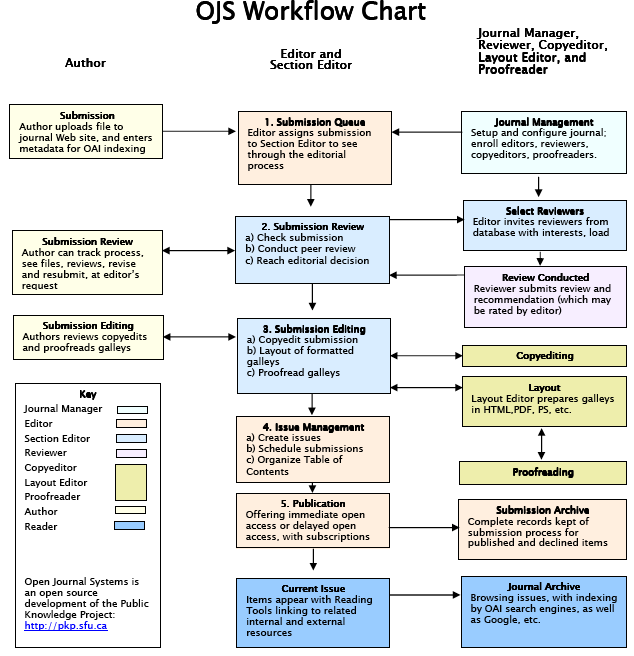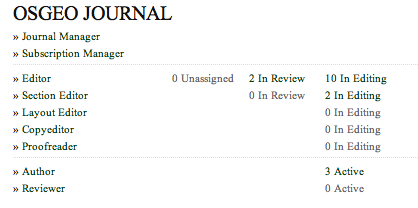Difference between revisions of "Journal System"
m |
m (adding workflow steps) |
||
| Line 4: | Line 4: | ||
| − | '''Current instance:''' http://osgeo.org/ojs - this is | + | '''Current instance:''' http://osgeo.org/ojs - this is the main portal for submitting and editing articles. |
| − | |||
---- | ---- | ||
| Line 14: | Line 13: | ||
[http://pkp.sfu.ca/files/OJSinanHour.pdf OJS In An Hour] - is a comprehensive review of all steps in using the system. | [http://pkp.sfu.ca/files/OJSinanHour.pdf OJS In An Hour] - is a comprehensive review of all steps in using the system. | ||
| + | |||
| + | == Process Overview == | ||
| + | === Authors === | ||
| + | # Register [https://www.osgeo.org/ojs/index.php/journal/user/register here] and choose the "author" and/or "reviewer" option during the registration page. Or Login here [https://www.osgeo.org/ojs/index.php/journal/login here] if you already have an account. | ||
| + | # Submit a new article [https://www.osgeo.org/ojs/index.php/journal/author/submit here] | ||
| + | # Your submission will be reviewed by editors and accepted, denied or asked for revisions. Watch your email for more contact from the Journal team. | ||
| + | |||
| + | === Editors === | ||
| + | # Login here [https://www.osgeo.org/ojs/index.php/journal/login here] | ||
| + | # It should advance you to your [http://www.osgeo.org/ojs/index.php/journal/user user home page] and list the articles that you are responsible for reviewing or editing. | ||
| + | # Select "# in editing", for example to see the article listing. | ||
| + | [[File:Ojs_editor_user_home.png]] | ||
== Video Tutorials == | == Video Tutorials == | ||
Revision as of 14:33, 27 September 2010
The OSGeo Journal project has begun using the PKP Open Journal System (OJS) for managing its workflow and publication. At the moment (Oct 07) it is being tested by loading the previous Journal Volume 2 into the system. Future Volumes will also use it.
Current instance: http://osgeo.org/ojs - this is the main portal for submitting and editing articles.
Workflow
The workflow for accepting submissions, reviewing them and approving them will slightly change. For now the system will be used for publishing and indexing the final content. There are metadata indexing portions of the system that will help people search, find and cite our articles more effectively. Also, it opens up the process to be better handled for peer review.
OJS In An Hour - is a comprehensive review of all steps in using the system.
Process Overview
Authors
- Register here and choose the "author" and/or "reviewer" option during the registration page. Or Login here here if you already have an account.
- Submit a new article here
- Your submission will be reviewed by editors and accepted, denied or asked for revisions. Watch your email for more contact from the Journal team.
Editors
- Login here here
- It should advance you to your user home page and list the articles that you are responsible for reviewing or editing.
- Select "# in editing", for example to see the article listing.
Video Tutorials
Tyler has put together a set of video tutorials, primarily for Section Editors and Authors to see how the main process works. They will be improved in the future but hopefully are somehow useful to show the whole workflow. You may want to follow along with the workflow graphic (below) while watching the video to understand what is happening.
The OJS team has some similar videos available [1]
- Video 1 - Author registration and submission
- Video 2 - Section Editor reviews the article and assigns a Reviewer to it
- Video 3 - The Reviewer takes his/her turn looking at the article, then sends it back to the Section Editor when complete - another version from OJS developers is available here
- Video 4 - The Section Editor acknowledges the Review and starts into Copyedit stage
- Video 5 - Copyediting steps, including Author review of edits
- Video 6 - Final proofing and publish by Journal Editor
Terms & Roles
Some terms used in the system may sound confusing if they are new to you. Here are the basics you need to know as an editor:
- OAI - The PKP Open Archives Harvester is a free metadata indexing system developed by the Public Knowledge Project
- Journal Manager - i.e. Editor in chief
- Copyeditor/Proofreader - reviews the text of papers for grammar, typography, etc.
- Galleys - preliminary versions of a published article for review purposes, i.e. a draft PDF (more) - not to be confused with a type of ship
Within the system, each user is given one or more roles. Roles define the functions that a user has available to use and what they are responsible to manage. Here are typical workflows for various scenarios. A comprehensive workflow diagram follows.
Authors
- Upload files and metadata
- Watches review process
- Reviews edits - this is a part that has traditionally been missing in previous editions of the Journal. OJS will help us streamline it.
Section Editors
- Automatically receive papers for your section
- Interact with reviewers & authors
- Finalise submissions
Reviewers / Proofreaders / Copyeditors
- Receive notices of papers to review
- Submit review comments
Journal Manager
- Coordinates process
- Participates in Journal-wide review
- Publishes final articles
- Submits to indexing engines
Here is a comprehensive workflow diagram:

References
- Online documentation, support forum and web site for the OJS
- Install notes for the OJS are almost identical to the SAC:Setup OCS item
